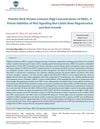A Possible Role of Keratinocytes of Skin and Mucous Membranes in Prion Propagation and Transmission
TLDR Skin cells might help spread prion diseases like Creutzfeldt-Jakob disease.
The document from 2002 investigated the expression of normal cellular prion protein (PrPc) in keratinocytes of the skin and mucous membranes, suggesting their potential role in the propagation and transmission of prions, which cause transmissible spongiform encephalopathies (TSEs) such as Creutzfeldt-Jakob disease (CJD). It was found that PrPc expression was minimal in normal human skin but upregulated in mucous membranes, inflammatory skin diseases, and epithelial tumors. The study also highlighted that prion protein (PrP^Sc) was not detected in the skin of variant CJD patients, but the involvement of keratinocytes in prion replication could not be ruled out, especially in inflamed skin. The document raised concerns about the risk of prion contamination in cultured keratinocytes used for skin transplants and suggested that compromised skin could serve as an entry point for prions, potentially leading to transmission through the lymphoid or central nervous system.

